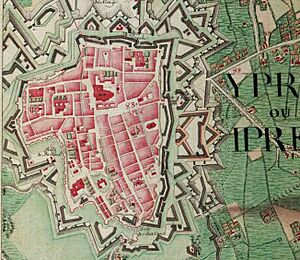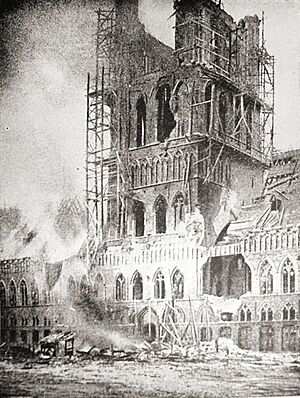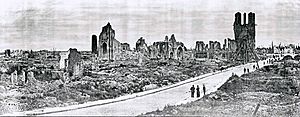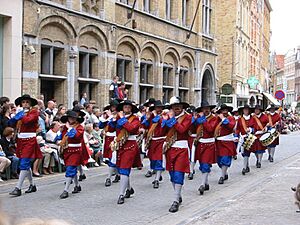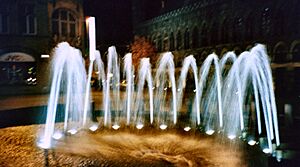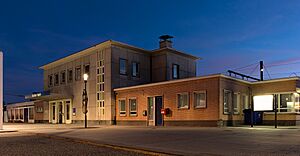Ypres facts for kids
Quick facts for kids
Ypres
Ieper (Dutch)
|
|||
|---|---|---|---|

Cloth Hall in the Grand Place
|
|||
|
|||
| Country | Belgium | ||
| Community | Flemish Community | ||
| Region | Flemish Region | ||
| Province | West Flanders | ||
| Arrondissement | Ypres | ||
| Area | |||
| • Total | 130.61 km2 (50.43 sq mi) | ||
| Population
(2018-01-01)Lua error in Module:Wd at line 1575: attempt to index field 'wikibase' (a nil value).
|
|||
| • Total | Lua error in Module:Wd at line 1,575: attempt to index field 'wikibase' (a nil value). | ||
| Postal codes |
8900, 8902, 8904, 8906, 8908
|
||
| Area codes | 057 | ||
Ypres (pronounced "EE-prə") is a historic city and municipality in Belgium. It's located in the province of West Flanders. While its official Dutch name is Ieper, the French name Ypres is often used in English. The city and its nearby villages are home to about 34,900 people.
Ypres holds a very important place in history, especially because of the First World War. During this war, Ypres was a key battleground between German and Allied forces. British soldiers often called it "Wipers."
Contents
Ypres: A City with a Rich Past
The Early Days of Ypres
Ypres is a very old town. People know it was visited by the Romans even before the first century BC. It was first officially mentioned in the year 1066. The city likely got its name from the Ieperlee river, where it was founded.
During the Middle Ages, Ypres was a busy and rich city in Flanders. By the year 1200, about 40,000 people lived there. It was famous for its linen trade with England. Even the famous book Canterbury Tales mentions Ypres's linen.
Ypres was the third-largest city in the County of Flanders, after Ghent and Bruges. It played a big role in the textile industry. Textiles from Ypres were sold in markets as far away as Russia in the early 12th century. In 1241, a large fire destroyed much of the old city. Ypres was involved in many important events, including battles and peace treaties.
The famous Cloth Hall was built in the 13th century. During this time, people used to throw cats from the Cloth Hall. This was possibly because they believed it would get rid of evil spirits. Today, a fun parade called the Cat Parade happens every three years to remember this old tradition.
Ypres was also captured by different forces over the centuries. In 1678, the French king Louis XIV of France took control. The city then became part of the Austrian Netherlands in 1713. Later, in 1794, the French captured it again.
Ypres has long had strong defenses to protect it from invaders. Parts of the old walls from 1385 can still be seen today. These defenses were made even stronger in the 17th and 18th centuries by military engineers like Sébastien Le Prestre de Vauban.
Ypres During World War I
Ypres was in a very important spot during the First World War. It was right in the path of Germany's plan to move through Belgium and into France. Because of this, the German army surrounded the city on three sides. They bombed Ypres for much of the war. To fight back, British, French, and other Allied forces tried to push the Germans back from the area known as the Ypres Salient.
The first major battle was the First Battle of Ypres in late 1914. The Allies managed to capture the town from the Germans. Then, in April 1915, the Second Battle of Ypres began. This battle was famous because it was the first time poison gas (chlorine) was used on a large scale. It was used against Canadian, British, and French soldiers. Later, in 1917, another type of gas called Mustard gas (also known as Yperite, after Ypres) was also used near the city.
The biggest and most difficult battle was the Third Battle of Ypres (also called the Battle of Passchendaele) in 1917. British, Canadian, Australian, New Zealand, and French forces fought for months. This battle caused nearly half a million casualties on all sides. Only a few miles of ground were gained by the Allies. By the end of the war, the city of Ypres was almost completely destroyed by artillery fire.
English-speaking soldiers often mispronounced Ypres as "Wipers." They even had a wartime newspaper called The Wipers Times. Other nearby towns also got nicknames, like Wytschaete becoming "White Sheet."
Ypres was also one of the places where soldiers from different sides had an unofficial Christmas Truce in 1914. They stopped fighting for a short time to celebrate Christmas.
Remembering the War
After the war, Ypres became a very special place for many people, especially British veterans. They saw it as a symbol of the sacrifices made during the war. Many people visited Ypres to remember the soldiers who fought and died there.
The city was mostly rebuilt after the war. Germany paid money for the rebuilding. The main square, including the Cloth Hall and town hall, was rebuilt to look as much like the original buildings as possible. Today, the Cloth Hall is home to the In Flanders Fields Museum. This museum tells the story of Ypres's role in the First World War.
Important Sights in Ypres
The Town Centre
The impressive Cloth Hall was built in the 13th century. It was one of the largest trading buildings in the Middle Ages. The building you see today is an exact copy of the original. It was rebuilt after being destroyed in the war. The tall tower on the hall, called a belfry, has 49 bells. This whole area is a World Heritage Site recognized by UNESCO.
The Gothic-style Saint Martin's Cathedral was built in 1221. It was also completely rebuilt after the war, now with a taller spire. Inside, you can find the tombs of important historical figures.
The Menin Gate Memorial
The Menin Gate Memorial to the Missing is a very important monument in Ypres. It remembers the soldiers from the British Commonwealth who died in the Ypres area during the First World War before August 1917 and whose bodies were never found.
The memorial was designed by Sir Reginald Blomfield. It was officially opened in 1927. The The Commonwealth War Graves Commission built and takes care of it.
The Menin Gate is located on the road leading out of town towards where the fighting happened. Many soldiers walked through this gate, never to return. Every evening since 1929, at exactly eight o'clock, a special ceremony takes place. Traffic stops, and buglers play the "Last Post" under the gate. This is done to honor the soldiers who fought and died there. During the Second World War, the Germans stopped the ceremony. But it started again on the very evening Ypres was freed in 1944.
The stone lions that used to stand at the original gate were given to Australia in 1936. This was to thank Australia for its sacrifices in the war. They are now at the Australian War Memorial in Canberra. In 2017, for the 100th anniversary of the Third Battle of Ypres, the original lions were brought back temporarily. Now, exact copies stand in their place, guarding the Menin Gate.
War Graves
The land around Ypres is covered with many war graves. You can find graves of both Allied and German soldiers. The largest cemeteries are Langemark German war cemetery and Tyne Cot Commonwealth war cemetery. The beautiful countryside around Ypres is mentioned in the famous poem In Flanders Fields by John McCrae.
Saint George's Memorial Church remembers the British and Commonwealth soldiers who died in the five battles fought for Ypres during World War I.
Events in Ypres
- The Cat Parade ("Kattenstoet") happens every three years on the second Sunday of May. During this fun event, stuffed toy cats are thrown from the belfry. There's also a colorful parade with cat and witch costumes.
- Ypres is also home to the Belgium Ypres Westhoek Rally, a car racing event that started in 1965. Famous rally drivers have taken part in it.
- An annual canoe polo tournament is held in Ypres, bringing teams from all over Europe.
- In 2014, the famous Tour de France bicycle race started one of its stages in Ypres.
- Every year in late August, Ypres hosts Ieperfest, a large hardcore metal music festival.
Ypres Today
Today, Ypres is known as a "city of peace." It has a special friendship with Hiroshima, another city deeply affected by war. Ypres was one of the first places where chemical warfare was used. Hiroshima was the first city to experience nuclear warfare. The city governments of Ypres and Hiroshima work together to make sure cities are never targets of war again. They also campaign for a world without nuclear weapons. Ypres hosts the international office for Mayors for Peace, a group of mayors working for nuclear disarmament.
Ypres is an important tourist destination because of its history. But it also has industrial areas. The biggest one is along the Ieperlee canal. This area has about 120 companies and even a wind farm. There's also the Ieper Business Park, which used to be home to a speech recognition company. Today, it provides jobs for about 1000 people.
Getting to Ypres
You can reach Ypres by train. Ieper railway station has hourly trains to Kortrijk. You can also get to Ypres from Brussels, which takes about 75 minutes by train.
Famous People from Ypres
- William of Ypres (died 1164), a military commander.
- Jacob Clemens non Papa (c. 1510–1556), a Renaissance composer.
- Cornelius Jansen (1585–1638), a bishop and religious leader.
- Jan Thomas van Ieperen (1617–1673), a Baroque painter.
- Jules Malou (1810–1886), a politician and former Prime Minister of Belgium.
- Antoon Verschoot (1925–2017), the chief bugler at the Menin Gate for many years.
- Emma Meesseman (born 1993), a professional basketball player.
Sister Cities
Ypres has friendly relationships with several cities around the world:
 Kazakhstan: Semey, Kazakhstan (since 2012)
Kazakhstan: Semey, Kazakhstan (since 2012) United Kingdom: Sittingbourne, United Kingdom (since 1964)
United Kingdom: Sittingbourne, United Kingdom (since 1964) Germany: Siegen, Germany (since 1967)
Germany: Siegen, Germany (since 1967) France: Saint-Omer, France (since 1969)
France: Saint-Omer, France (since 1969) Ghana: Wa, Ghana
Ghana: Wa, Ghana
See also
 In Spanish: Ypres para niños
In Spanish: Ypres para niños





